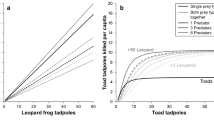Summary
The influences of hunger and prey size on prey selection by the stonefly Hesperoperla pacifica (Perlidae) were explored in the laboratory by observing behavioral responses toward ten prey taxa and three nonprey taxa. Patterns of behavior were consistent with most assumptions and predictions of optimal foraging theory predicting sizebased prey selection by pursuing predators. Handling time appeared to increase as an exponential function of prey mass, and prey profitability (mg/s) was highest for small and intermediate-sized prey. Fasted stoneflies consumed a wide range of prey sizes, whereas well-fed stoneflies concentrated their attacks on intermediate-sized prey. Responses of H. pacifica to nonprey taxa, however, suggest that prey recognition and selection are not based on size alone.
Similar content being viewed by others
References
Allan JD (1982) Feeding habits and prey consumption of three setipalpian stoneflies (Plecoptera) in a mountain stream. Ecology 63:26–34
Baumann RW, Gaufin AR, Surdick RF (1977) The stoneflies (Plecoptera) of the Rocky Mountains. Mem Am Entomol Soc 31
Brink P (1949) Studies on swedish stoneflies (Plecoptera). Opusc Ent Suppl 11:1–246
Cather MR, Gaufin AR (1975) Life history and ecology of Megarcys signata (Plecoptera: Perlodidae), Mill Creek, Wasatch Mountains, Utah. Great Basin Nat 35:39–48
Charnov EL (1976) Optimal foraging: attack strategy of a mantid. Am Nat 110:141–151
Cummins KW, Wuycheck JC (1971) Caloric equivalents for investigations in ecological energetics. Mitt Int Ver Limnol No 18
Dodds GS, Hisaw FL (1925) Ecological studies on aquatic insects. IV. Altitudinal range and zonation of mayflies, stoneflies and caddisflies in the Colorado Rockies. Ecology 6:380–390
Fuller RL, Stewart KW (1977) The food habits of stoneflies (Plecoptera) in the upper Gunnison River, Colorado. Environ Ent 6:293–302
Holling CS (1966) The functional response of invertebrate predators to prey density. Mem Ent Soc Can 48:1–86
Hynes HBN (1941) The taxonomy and ecology of the nymphs of the British Plecoptera with notes on the adults and eggs. Trans Roy Ent Soc Lond 91:459–557
Hynes HBN (1976) Biology of Plecoptera. Annu Rev Entomol 21:135–153
Ivlev VS (1961) Experimental ecology of the feeding of fishes. Yale Univ Press, New Haven
Krebs JR (1978) Optimal foraging: decision rules for predators. In: Krebs JR, Davies NB (eds), Behavioral ecology an evolutionary approach, Blackwell, Oxford Melbourne, pp 23–63
Krebs JR, Houston AI, Charnov EL (1980) Some recent developments in optimal foraging. In: Kamil AC, Sargent T (eds), Foraging behavior: ecological, ethological and psychological approaches, Garland STPM, New York, pp 3–18
Johnson JH (1981) Food habits and dietary overlap of perlid stoneflies (Plecoptera) in a tributary of Lake Ontario. Can J Zool 59:2030–2037
Mackereth JC (1957) Notes on the Plecoptera from a stony stream. J Anim Ecol 26:343–351
McClintock JB (1986) On estimating energetic values of prey: implications in optimal diet models. Oecologia (Berlin) 70:161–162
Malmqvist B, Sjöström P (1980) Prey size and feeding patterns in Dinocras cephalotes (Plecoptera). Oikos 35:311–316
Minshall GW, Minshall JN (1966) Notes on the life history and ecology of Isoperla clio (Newman) and Isogenus decisus Walker (Plecoptera: Perlodidae) Am Midl Nat 76:340–350
Molles MC Jr, Pietruszka RD (1983) Mechanisms of prey selection by predaceous stoneflies: roles of prey morphology, behavior and predator hunger. Oecologia (Berlin) 57:25–31
Muttkowski RA, Smith GW (1929) The food of trout stream insects in Yellowstone National Park. Roosevelt Wildlife Ann 2:241–263
Pastorok RA (1980) The effects of predator hunger and food abundance on prey selection by Chaoborus larvae. Limnol Oceanogr 25:910–921
Peckarsky BL (1980) Behavioral interactions between stoneflies and mayflies: behavioral observations. Ecology 61:932–943
Peckarsky BL (1982) Aquatic insect predator-prey relations. Bio Science 32:261–266
Pulliam HR (1974) On the theory of optimal diets. Am Nat 108:59–74
Pyke GH (1984) Optimal foraging theory: a critical review. Ann Rev Ecol Syst 15:523–575
Pyke GH, Pulliam HR, Charnov EL (1977) Optimal foraging: a selective review of theory and tests. Q Rev Biol 52:137–154
Schoener TW (1969) Models of optimal size for solitary predators. Am Nat 103:277–313
Schoener TW (1971) Theory of feeding strategies. Ann Rev Ecol Syst 2:369–404
Schoener TW (1974) The compression hypothesis and temporal resource partitioning. Proc Natl Acad Sci USA 71:4169–4172
Schoener TW (1979) Generality of the size-distance relation in models of optimal foraging feeding. Am Nat 114:902–914
Sheldon AL (1969) Size relationships of Acroneuria californica and its prey. Hydrobiol 34:85–94
Sheldon AL (1980) Resource division by perlid stoneflies (Plecoptera) in a lake outlet ecosystem. Hydrobiol 71:155–161
Siegfried CA, Knight AW (1976) Prey selection by a setipalpian stonefly nymph, Acroneuria (Calineuria) californica Banks (Plecoptera: Perlidae). Ecology 57:603–608
Snellen RK, Stewart KW (1979) The life cycle of Perlesta placida (Plecoptera: Perlidae) in an intermittent stream in Northern Texas. Ann Ent Soc Am 72:659–666
Tarter DC, Krumholz LA (1971) Life history and ecology of Paragnetina media (Walker) (Insecta: Plecoptera) in Doe Run, Meade County, Kentucky. Am Midl Nat 86:169–180
Vaught GL, Stewart KW (1974) The life history and ecology of the stonefly Neoperla clymene (Newman) (Plecoptera: Perlidae). Ann Ent Soc Am 67:167–178
Walton OE Jr (1980) Invertebrate drift from predatory-prey associations. Ecology 61:1486–1497
Wilkinson L (1984) SYSTAT. SYSTAT, Evanston, Illinois
Author information
Authors and Affiliations
Rights and permissions
About this article
Cite this article
Molles, M.C., Pietruszka, R.D. Prey selection by a stonefly: the influence of hunger and prey size. Oecologia 72, 473–478 (1987). https://doi.org/10.1007/BF00377582
Received:
Issue Date:
DOI: https://doi.org/10.1007/BF00377582




